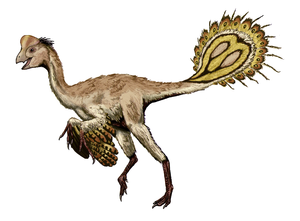Nomingia
| Nomingia | ||||||||||||
|---|---|---|---|---|---|---|---|---|---|---|---|---|

Live reconstruction of Nomingia gobiensis |
||||||||||||
| Temporal occurrence | ||||||||||||
| Upper Cretaceous (early Maastrichtian ) | ||||||||||||
| 72 to 69.9 million years | ||||||||||||
| Locations | ||||||||||||
| Systematics | ||||||||||||
|
||||||||||||
| Scientific name | ||||||||||||
| Nomingia | ||||||||||||
| Barsbold et al. , 2000 | ||||||||||||
| Art | ||||||||||||
|
||||||||||||
Nomingia was a theropod dinosaur from the group of oviraptorosauria from the Upper Cretaceous of Mongolia . This genus is known from a partial skeleton, on the basis of which the only species Nomingia gobiensis was first described in 2000. It was an estimated 1.8 meters long, two-legged running animal with a short tail. Although skull bones are unknown, Nomingia, like other oviraptorosaurs, is believed to havea deep, toothless jaw that was shaped into a beak. Presumably it was herbivorous or omnivorous .
The systematic position within the Oviraptorosauria has not been established. Features on the iliac and ischium show, however, that the genus can possibly be classified within the Caenagnathidae .
Find and naming
The only find so far ( holotype ; catalog number GIN 100/119) was made in 1994 by a Mongolian-Japanese expedition in Bugin Tsav in Aimag Bajanchongor , Mongolia . The remains of the Oviraptoriden Ajancingenia come from the same site . Stratigraphically , the fossils come from sedimentary rocks of the Bugin Tsav Beds, which belong to the Nemegt Formation and are approximately 71 to 69 million years old (early Maastrichtian ). The spinal column of the partial skeleton has remained completely anatomically connected from the last two cervical vertebrae to the end of the tail, so 13 presacral vertebrae (dorsal vertebrae and 1 to 3 cervical vertebrae), 5 sacral vertebrae (sacral vertebrae) and 24 caudal vertebrae including most of the chevron bones are known. Furthermore, the skeleton consists of 10 fragmentary ribs, some gastralia , the entire pelvic region, the left thigh bone and the tibia and fibula of both legs. The name Nomingia is derived from Nomingiin Gobi, a part of the Gobi desert near the site. The specific epitheth gobiensis is derived from the Gobi desert itself.
features
The most important feature discovered in Nomingia is the merging of the last five caudal vertebrae. This structure, known as pygostyle , is otherwise only found in birds, although in 2008 another oviraptorosaur with a pygostyle was described with Similicaudipteryx . It is likely that the pygostyle evolved convergently (independently) in birds and oviraptorosaurs . In birds, the pygostyle serves to support the long tail feathers, which is why the first description suggests that Nomingia could also have carried a fan made of long tail feathers. Feathers have not been preserved in Nomingia , but due to the pygostyle it seems very likely that this oviraptorosaur was feathered.
The tail was very short and consisted of only 24 caudal vertebrae, so Nomingia had the second shortest tail of all known theropods - only Caudipteryx had an even shorter tail with only 22 caudal vertebrae. The chevron bones were wide and ran the entire underside of the tail except for the pygostyle. Other unique features ( autapomorphies ) of Nomingia were evident in the pelvic bones; for example, the pubis was inclined 20 degrees from the vertical. Nomingia shared other characteristics with other oviraptorosaurs, which justifies the classification within this group ( synapomorphies ), such as the large pituitary glands on three vertebrae at the transition between the back and the neck and the pneumatized (hollowed out) anterior caudal vertebrae.
literature
Unless otherwise stated, all information comes from the following work:
- Rinchen Barsbold , Halszka Osmólska , Mahito Watabe, Philip J. Currie , Khishigjaw Tsogtbaatar: A new oviraptorosaur (Dinosauria, Theropoda) from Mongolia: The first dinosaur with a pygostyle. In: Acta Palaeontologica Polonica. Vol. 45, No. 2, 2000, ISSN 0567-7920 , pp. 97-106, digitized version (PDF; 1.73 MB) .
Individual evidence
- ^ Gregory S. Paul : The Princeton Field Guide To Dinosaurs. Princeton University Press, Princeton NJ et al. 2010, ISBN 978-0-691-13720-9 , p. 152, online .
- ↑ Michael Mortimer: Oviraptorosauria. In: The Theropod Database. Archived from the original on January 29, 2013 ; Retrieved July 30, 2014 .
- ↑ a b c Rinchen Barsbold, Philip J. Currie, Nathan P. Myhrvold, Halszka Osmólska, Khishigjaw Tsogtbaatar, Mahito Watabe: A pygostyle from a non-avian theropod. In: Nature . Vol. 403, No. 6766, 2000, pp. 155-156, doi : 10.1038 / 35003103 .
- ↑ Tao He, Xiao-Lin Wang, Zhong-He Zhou : A new genus and species of caudipterid dinosaur from the Lower Cretaceous Jiufotang Formation of western Liaoning, China. In: Vertebrata PalAsiatica. Vol. 46, No. 3, 2008, ZDB -ID 2485763-4 , pp. 178-189, [digital version (PDF; 1.82 MB)].
- ↑ Halszka Osmólska, Philip J. Currie, Rinchen Barsbold: Oviraptorosauria. In: David B. Weishampel , Peter Dodson , Halszka Osmólska (eds.): The Dinosauria . 2nd edition. University of California Press, Berkeley CA et al. 2004, ISBN 0-520-24209-2 , pp. 165-183, here p. 183.
Web links
- A skeletal reconstruction of Nomingia at Skeletal-Drawing
